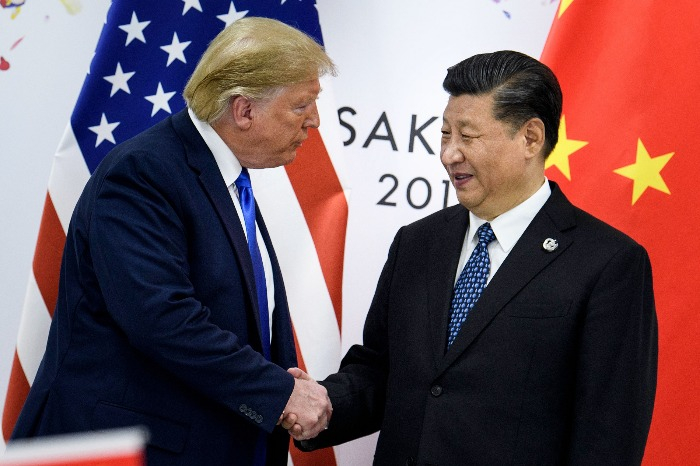Perspectives
Biden must ensure US allies aren’t China collateral damage
Feb 15, 2023 (Gmt+09:00)
4
Min read
Most Read
LG Chem to sell water filter business to Glenwood PE for $692 million


Kyobo Life poised to buy Japan’s SBI Group-owned savings bank


KT&G eyes overseas M&A after rejecting activist fund's offer


StockX in merger talks with Naver’s online reseller Kream


Mirae Asset to be named Korea Post’s core real estate fund operator



The biggest irony about China-US relations today is just how much Xi Jinping misses Donald Trump.
China’s leader would never admit this. Nor did Xi’s Communist Party enjoy the former US president’s tariffs, social media tantrums and general mendacity. But Trump’s efforts to kneecap China were too chaotic and inept to stop Asia’s biggest economy. China found ways around Trump’s largely performative trade war.
Yet Joe Biden’s quieter and surgical moves to hobble China’s tech sector are doing real — and increasing — damage. The current US leader doesn’t tweet at Xi. Rather, Biden is depriving Xi of the technology needed to raise China’s innovative game. This White House is still turning up the heat in ways of which the Trump gang could only dream.

As Republicans in Congress panic over Chinese balloons in the sky, Biden is making the mainland’s tech future a smaller blip on economic radar screens.
Yet there’s a side effect of all this that deserves more attention: how Biden’s China policies are unnerving key allies in South Korea and Japan.
Korea especially. Semiconductors represent the biggest source of income for Korea’s economy. China is both the world’s largest semiconductor market and Korea’s biggest trade partner. As sales shortfalls at chip giants Samsung Electronics Co., SK Hynix Inc. and others can attest, being a top US ally is proving very expensive.
Of course, Korea Inc. is also reeling over a US law passed in August to limit $7,500 tax credits for electric vehicles to those assembled inside North America. It generated new headwinds for Hyundai Motor Co. and Kia Corp., which make EVs in Korea and export them overseas.
Yet Biden’s Feb. 8 State of the Union signaled a sharper pivot toward restoring America’s role as manufacturing power. As he stressed “build more, and build it here,” Biden doubled down on a “buy America” industrial policy that put allies in Seoul and Tokyo in a tough spot.
Written between the lines in bold font: hope, even an expectation, that other leading democracies in Asia will follow Washington’s lead. With a 2024 presidential cycle beginning, might the US find offense if Korea continues to invest in advanced technologies in China?
Biden, after all, wants to grow America’s semiconductor manufacturing presence to create jobs and increase competitiveness. Can President Yoon Suk-yeol successfully walk a tightrope between Washington and Beijing — Seoul’s “strategic equilibrium” — without alienating one or perhaps both? It will be easier said than done as China becomes America’s top election issue.
Odds are, Biden will be lobbying Samsung and SK to invest more in the US. Last May, Hyundai Motor upped the ante on Korea Inc. peers by pledging to invest $10 billion in the US by 2025. Biden is surely thinking there’s more where that came from.
All the while, rumors of US-China decoupling are proving greatly exaggerated. In 2022, two-way trade between the two biggest economies spiked despite tensions. US imports from China rose $32 million to $537 billion in 2022. Biden’s economy shipped a record $154 billion in exports to Xi’s nation.
If the US wants Korea to pivot away from China, it’s hardly leading by example. Korea risks being collateral damage as Team Biden hobbles Chinese tech. Last year’s passage of the CHIPS and Science Act and the Inflation Act threw Korean tech companies into compliance hell.
Corporate executives must be careful that plans for building advanced semiconductor factories over the next decade won’t run afoul of Washington’s new red lines. Might Samsung have to cut production in Xi’an or SK in Wuxi? And what blowback might come if Korean technology finds its way, unwittingly, into Chinese lasers, weapons, air-defense systems and surveillance tools?
Biden’s team would be wise to focus more on building innovative muscle at home and less on deflating China’s tires. Granted, Biden got off to a solid start. The CHIPS Act alone threw nearly $300 billion at boosting domestic research and development.
It marked a U-turn from the Trump era. Trump disrupted trade and signed a ginormous $1.8 trillion tax cut. But he neglected domestic capacity building. Had lower taxes boosted innovation and productivity, US inflation might not be at 40-year highs.
Biden should go much further to take on China’s multi-trillion-dollar plan to be the dominant power in EVs, semiconductors, artificial intelligence, renewable energy, robotics, biotechnology, aviation, high-speed rail, you name it. But do more of it at home.
This would create new wealth and make the economic pie bigger. It would vastly increase America’s economic footprint in Korea, boosting demand for electronics, vehicles and entertainment exports.
It’s time Biden’s team got real about shielding Korea from negative fallout from trade policies. Biden is determined to transform America to rise to the China challenge, and that’s great. Let’s just be sure not to do it at Korea’s expense.
By William Pesek
William Pesek is an award-winning Tokyo-based journalist and author of Japanization: What the World Can Learn from Japan's Lost Decades. Previously, he was a columnist for Bloomberg and Barron’s.
More to Read
-
 PerspectivesChina’s COVID reopening poses risks and opportunities
PerspectivesChina’s COVID reopening poses risks and opportunitiesDec 15, 2022 (Gmt+09:00)
4 Min read -
 PerspectivesSouth Korea’s uncomfortable place between US and China
PerspectivesSouth Korea’s uncomfortable place between US and ChinaSep 15, 2022 (Gmt+09:00)
4 Min read -
 Bio & PharmaBiden’s move to beef up US bio industry poses threat to Korean firms
Bio & PharmaBiden’s move to beef up US bio industry poses threat to Korean firmsSep 14, 2022 (Gmt+09:00)
3 Min read
Comment 0
LOG IN


